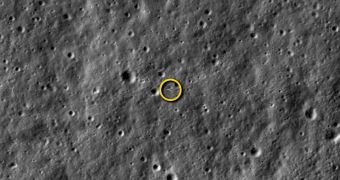Officials at the American space agency revealed on Wednesday, January 29, that the Lunar Reconnaissance Orbiter (LRO) was able to snap a photo of the NASA Lunar Atmosphere and Dust Environment Explorer (LADEE) spacecraft, on January 15, 2014.
The two spacecraft may have a similar mission – to orbit the Moon and collect more data on Earth's natural satellite – but their capabilities and flight paths are very different. LRO, for example, uses an equatorial orbit that has it moving east to west around the Moon.
On the other hand, LADEE uses a polar orbit, similar to those used by weather and spy satellites around Earth, which has it moving south to north. From time to time, the two spacecraft pass close to each other, such as was the case two weeks ago. With careful timing, NASA experts were able to catch a furtive glimpse at LADEE while it was passing beneath LRO.
The image was snapped using the Lunar Reconnaissance Orbiter Camera (LROC) instrument, while the two vehicles were 9 kilometers (5.6 miles) away from each other. LADEE was moving too fast to allow LROC a clear image of its body, solar panels and scientific instruments.
In addition to the high speed, the inner limitations of LROC also played a role in producing an unclear image. The instrument uses a push-broom design, which means that it captures a single line at a time. This makes photographing small, fast-moving objects very difficult.
Both vehicles move around the Moon at a speed of around 1,600 meters per second, or 3,600 miles per hour. In order to make even this unclear photograph possible, LROC operators had to push the instruments, and their knowledge of timing and pointing, to the limits.
LADEE was only visible to the Narrow Angle Camera on LRO for 1.35 milliseconds, but this was enough time to produce the image attached to this article. The photo has an overall blur level of 50 centimeters (20 inches), and a pixel size of 3.5 to 20 inches (8.9 to 51 centimeters).
While LADEE is the latest NASA arrival at the Moon, having been launched on September 6, 2013, LRO is a veteran observer. The spacecraft was launched on September 18, 2009, alongside the Lunar Crater Observation and Sensing Satellite (LCROSS) impactor.
LRO is managed by scientists at the NASA Goddard Space Flight Center (GSFC), in Greenbelt, Maryland, while LADEE is controlled from the agency's Ames Research Center (ARC), in Moffett Field, California.

 14 DAY TRIAL //
14 DAY TRIAL //